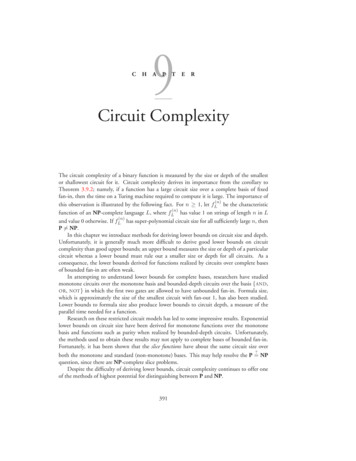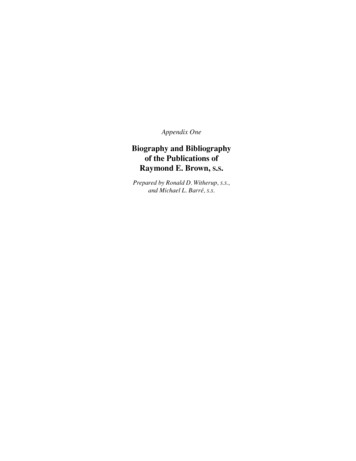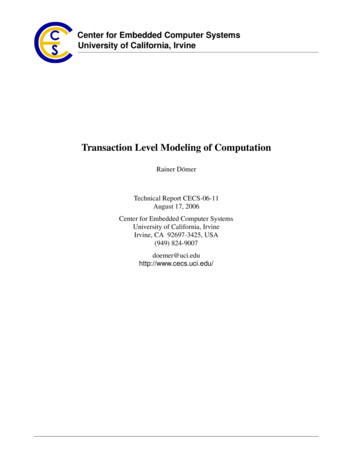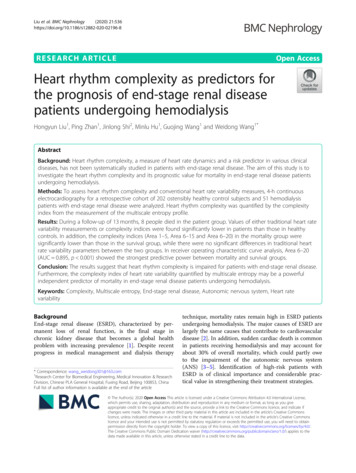
Transcription
CHAPTERCircuit ComplexityThe circuit complexity of a binary function is measured by the size or depth of the smallestor shallowest circuit for it. Circuit complexity derives its importance from the corollary toTheorem 3.9.2; namely, if a function has a large circuit size over a complete basis of fixedfan-in, then the time on a Turing machine required to compute it is large. The importance of(n)this observation is illustrated by the following fact. For n 1, let fL be the characteristic(n)function of an NP-complete language L, where fL has value 1 on strings of length n in L(n)and value 0 otherwise. If fL has super-polynomial circuit size for all sufficiently large n, thenP NP.In this chapter we introduce methods for deriving lower bounds on circuit size and depth.Unfortunately, it is generally much more difficult to derive good lower bounds on circuitcomplexity than good upper bounds; an upper bound measures the size or depth of a particularcircuit whereas a lower bound must rule out a smaller size or depth for all circuits. As aconsequence, the lower bounds derived for functions realized by circuits over complete basesof bounded fan-in are often weak.In attempting to understand lower bounds for complete bases, researchers have studiedmonotone circuits over the monotone basis and bounded-depth circuits over the basis {AND,OR , NOT } in which the first two gates are allowed to have unbounded fan-in. Formula size,which is approximately the size of the smallest circuit with fan-out 1, has also been studied.Lower bounds to formula size also produce lower bounds to circuit depth, a measure of theparallel time needed for a function.Research on these restricted circuit models has led to some impressive results. Exponentiallower bounds on circuit size have been derived for monotone functions over the monotonebasis and functions such as parity when realized by bounded-depth circuits. Unfortunately,the methods used to obtain these results may not apply to complete bases of bounded fan-in.Fortunately, it has been shown that the slice functions have about the same circuit size over?both the monotone and standard (non-monotone) bases. This may help resolve the P NPquestion, since there are NP-complete slice problems.Despite the difficulty of deriving lower bounds, circuit complexity continues to offer oneof the methods of highest potential for distinguishing between P and NP.391
392Chapter 9 Circuit ComplexityModels of Computation9.1 Circuit Models and MeasuresIn this section we characterize types of logic circuits by their bases and the fan-in and fanout of basis elements. We consider bases that are complete and incomplete and that havebounded and unbounded fan-in. We also consider circuits in which the fan-out is restrictedand unrestricted. Each of these factors can affect the size and depth of a circuit.9.1.1 Circuit ModelsThe (general) logic circuit is the graph of a straight-line program in which the variables havevalue 0 or 1 and the operations are Boolean functions g : Bp B, p 1. (Boolean functionshave one binary value. Logic circuits are defined in Section 1.2 and discussed at length inChapter 2.) The vertices in a logic circuit are labeled with Boolean operations and are calledgates; the set of different gate types used in a circuit is called the basis (denoted Ω) for thecircuit. The fan-in of a basis is the maximal fan-in of any function in the basis. A circuitcomputes the binary function f : Bn Bm , which is the mapping from the n circuit inputsto the m gate outputs designated as circuit outputs.The standard basis, denoted Ω0 , is the set {AND, OR, NOT} in which AND and OR havefan-in 2. The full two-input basis, denoted B2 , consists of all two-input Boolean functions.The dyadic unate basis, denoted U2 , consists of all Boolean functions of the form (xa y b )cfor constants a, b, c in B. Here x1 x and x0 x.A basis Ω is complete if every binary function can be computed by a circuit over Ω. Thebases Ω0 , B2 , and U2 are complete, as is the basis consisting of the NAND gate computing thefunction x NAND y x y. (See Problem 2.5.)The bounded fan-out circuit model specifies a bound on the fan-out of a circuit. As weshall see, the fan-out-1 circuit plays a special role related to circuit depth. Each circuit offan-out 1 corresponds to a formula in which the operators are the functions associated withvertices of the circuit. Figure 9.1 shows an example of a circuit of fan-out 1 over the standardbasis and its associated formula. (See also Problem 9.9.) Although each input variable appearsonce in this example, Boolean functions generally require multiple instances of variables (havefan-out greater than 1). Formula size is studied at length in Section 9.4.To define the monotone circuits, we need an ordering of binary n-tuples. Two such tuples,x (x1 , x2 , . . . , xn ) and y (y1 , y2 , . . . , yn ), are in the relation x y if for all 1 i n,xi yi , where 0 0, 1 1, and 0 1, but 1 0. (Thus, 001011 101111, but011011 101111.)A monotone circuit is a circuit over the monotone basis Ωmon {AND, OR} in whichthe fan-in is 2. There is a direct correspondence between monotone circuits and monotonefunctions. A monotone function is a function f : Bn Bm that is either monotoneincreasing, that is, for all x, y Bn , if x y, then f (x) f (y), or is monotonedecreasing, that is, for all x, y Bn , if x y, then f (x) f (y). Unless stated explicitly, amonotone function will be understood to be a monotone increasing function.A monotone Boolean function has the following expansion on the first variable, as thereader can show. (See Problem 9.10.) A similar expansion is possible on any variable.f (x1 , x2 , . . . , xn ) f (0, x2 , . . . , xn ) (x1 f (1, x2 , . . . , xn ))By applying this expansion to every variable in succession, we see that each monotone functioncan be realized by a circuit over the monotone basis. Furthermore, the monotone basis Ωmon
c JohnE Savage9.1 Circuit Models and Measures393y ((((x7 x6 ) (x5 x4 )) x3 ) (x2 x1 ))x3x7 x6x2 x1x5 x4Figure 9.1 A circuit of fan-out 1 over a basis with fan-in 2 and a corresponding formula. Thevalue y at the root is the AND of the value (((x7 x6 ) (x5 x4 )) x3 ) of the left subtree withthe value (x2 x1 ) of the right subtree.is complete for the monotone functions, that is, every monotone function can be computedby a circuit over the basis Ωmon . (See Problem 2.)In Section 9.6 we show that some monotone functions on n variables require monotonecircuits whose size is exponential in n. In particular, some monotone functions requiringexponential-size monotone circuits can be realized by polynomial-size circuits over the standardbasis Ω0 . Thus, the absence of negation can result in a large increase in circuit size.The bounded-depth circuit is a circuit over the standard basis Ω0 where the fan-in of ANDand OR gates is allowed to be unbounded, but the circuit depth is bounded. The conjunctiveand disjunctive normal forms and the product-of-sums and sum-of-products normal formsrealize arbitrary Boolean functions by circuits of depth 2 over Ω0 . (See Section 2.3.) In thesenormal forms negations are used only on the input variables. Note that any circuit over thestandard basis can be converted to a circuit in which the NOT gates are applied only to theinput variables. (See Problem 9.11.)9.1.2 Complexity MeasuresWe now define the measures of complexity studied in this chapter. The depth of a circuit isthe number of gates of fan-in 2 or more on the longest path in the circuit. (Note that NOTgates do not affect the depth measure.)9.1.1 The circuit size of a binary function f : Bn Bm with respect to the basisΩ, denoted CΩ (f ), is the smallest number of gates in any circuit for f over the basis Ω. The circuitsize with fan-out s, denoted Cs,Ω (f ), is the circuit size of f when the circuit fan-out is limitedto at most s.DEFINITION
394Chapter 9 Circuit ComplexityModels of ComputationThe circuit depth of a binary function f : Bn Bm with respect to the basis Ω, DΩ (f ), isthe depth of the smallest depth circuit for f over the basis Ω. The circuit depth with fan-out s,denoted Ds,Ω (f ), is the circuit depth of f when the circuit fan-out is limited to at most s.The formula size of a Boolean function f : Bn B with respect to a basis Ω, LΩ (f ), is theminimal number of input vertices in any circuit of fan-out 1 for f over the basis Ω.It is important to note the distinction between formula and circuit size: in the formerthe number of input vertices is counted, whereas in the latter it is the number of gates. Arelationship between the two is shown in Lemma 9.2.2.9.2 Relationships Among Complexity MeasuresIn this section we explore the effect on circuit complexity measures of a change in either thebasis or the fan-out of a circuit. We also establish relationships between circuit depth andformula size.9.2.1 Effect of Fan-Out on Circuit SizeIt is interesting to ask how the circuit size and depth of a function change as the maximal fanout of a circuit is reduced. This issue is important in understanding these complexity measuresand in the use of technologies that limit the fan-out of gates. The following simple facts abouttrees are useful in comparing complexity measures. (See Problem 9.2.)LEMMA 9.2.1 A rooted tree of maximal fan-in r containing k vertices has at most k(r 1) 1leaves and a rooted tree with l leaves and fan-in r has at most l 1 vertices with fan-in 2 or moreand at most 2(l 1) edges.From the above result we establish the following connection between circuit size with fanout 1 and formula size.9.2.2 Let Ω be a basis of fan-in r. For each f : Bn B the following inequalities holdbetween formula size, LΩ (f ), and fan-out-1 circuit size, C1,Ω (f ):LEMMA(LΩ (f ) 1)/(r 1) C1,Ω (f ) 3LΩ (f ) 2Proof The first inequality follows from the definition of formula size and the first resultstated in Lemma 9.2.1 in which k C1,Ω (f ). The second inequality also follows fromLemma 9.2.1. A tree with LΩ (f ) leaves has at most LΩ (f ) 1 vertices with fan-in of 2 ormore and at most 2(LΩ (f ) 1) edges between vertices (including the leaves). Each of theseedges can carry a NOT gate, as can the output gate, for a total of at most 2LΩ (f ) 1 NOTgates. Thus, a circuit of fan-out 1 has at most 3LΩ (f ) 2 gates.As we now show, circuit size increases by at most a constant factor when the fan-out of thecircuit is reduced to s for s 2. Before developing this result we need a simple fact about acomplete basis Ω, namely, that at most two gates are needed to compute the identity functioni(x) x, as shown in the next paragraph. If a basis contains AND or OR gates, the identityfunction can be obtained by attaching both of their inputs to the same source.We are done if Ω contains a function such that by fixing all but one variable, i(x) iscomputed. If not, then we look for a non-monotone function in Ω. Since some binary
c JohnE Savage9.2 Relationships Among Complexity Measures395functions are non-monotone (x, for example), some function g in a complete basis Ω is nonmonotone. This means there exist tuples x and y for g, x y, such that g(x) 1 g(y) 0. Let u and v be the largest and smallest tuples, respectively, satisfying x u v yand g(u) 1 and g(v) 0. Then u and v differ in at most one position. Without lossof generality, let that position be the first and let the values in the remaining positions inboth tuples be (c2 , . . . , cn ). It follows that g(1, c2 , . . . , cn ) 0 and g(0, c2 , . . . , cn ) 1 org(x, c2 , . . . , cn ) x. If l(Ω) is the number of gates from Ω needed to realize the identityfunction, then l(Ω) 1 or 2.THEOREM9.2.1 Let Ω be a complete basis of fan-in r and let f : Bn Bm . The followinginequalities hold on Cs,Ω (f ):CΩ (f ) Cs 1,Ω (f ) Cs,Ω (f ) C1,Ω (f )Furthermore, Cs,Ω (f ) has the following relationship to CΩ (f ) for s 2: l(Ω)(r 1)Cs,Ω (f ) CΩ (f ) 1 s 1Proof The first set of inequalities holds because a smallest circuit with fan-out s is no smallerthan a smallest circuit with fan-out s 1, a less restrictive type of circuit.The last inequality follows by constructing a tree of identity functions at each gate whosefan-out exceeds s. (See Fig. 9.2.) If a gate has fan-out φ s, reduce the fan-out to s andthen attach an identity gate to one of these s outputs. This increases the fan-out from s tos s 1. If φ is larger than this number, repeat the process of adding an identity gate ktimes, where k is the smallest integer such that s k(s 1) φ or is the largest integersuch that s (k 1)(s 1) φ. Thus, k (φ 1)/(s 1).Let φi denote the fan-out of the ith gate in a circuit for f of potentially unboundedfan-out and let ki be the largest integer satisfying the following bound:ki φi 1s 1Then at most i (ki l(Ω) 1) gates are needed in the circuit of fan-out s to realize f ,one for the ith gate in the original circuit and ki l(Ω) gates for the ki copies of the identity(a)(b)Figure 9.2 Conversion of a vertex with fan-out more than s to a subtree with fan-out s,illustrated for s 2.
396Chapter 9 Circuit ComplexityModels of Computationfunction at the ith gate. Note that i φi is the number of edges directed away from gatesin the original circuit. But since each edge directed away from a gate is an edge directed intoa gate, this number is at most rCΩ (f ) since each gate has fan-in at most r.It follows that the smallest number of gates in a circuit with fan-out s for f satisfies thefollowing bound: CΩ (f )Cs,Ω (f ) CΩ (f ) l(Ω)i 1φi 1s 1 CΩ (f ) 1 l(Ω)(r 1)s 1 which demonstrates that circuit size with a fan-out s 2 differs from the unbounded fanout circuit size by at most a constant factor.With the construction employed in Theorem 9.2.1, an upper bound can be stated onDs,Ω (f ) that is proportional to the product of DΩ (f ) and log CΩ (f ). (See Problem 9.12.)The upper bound stated above on Cs,Ω (f ) can be achieved by a circuit that also achieves anupper bound on Ds,Ω (f ) that is proportional to DΩ (f ) and logr s [138].9.2.2 Effect of Basis Change on Circuit Size and DepthWe now consider the effect of a change in basis on circuit size and depth. In the next sectionwe examine the relationship between formula size and depth, from which we deduce the effectof a basis change on formula size.LEMMA9.2.3 Given two complete bases, Ωa and Ωb , and a function f : Bn Bm , the circuitsize and depth of f in these two bases differ by at most constant multiplicative factors.Proof Because each basis is complete, every function in Ωa can be computed by a fixednumber of gates in Ωb , and vice versa. Given a circuit with basis Ωa , a circuit with basisΩb can be constructed by replacing each gate from Ωa by a fixed number of gates fromΩb . This has the effect of increasing the circuit size by at most a constant factor. It followsthat CΩa (f ) Θ(CΩb (f )). Since this construction also increases the depth by at most aconstant factor, it follows that DΩa (f ) Θ(DΩb (f )).9.2.3 Formula Size Versus Circuit DepthA logarithmic relationship exists between the formula size and circuit depth of a function, aswe now show. If a formula is represented by a balanced tree, this result follows from the factthat the circuit fan-in is bounded. However, since we cannot guarantee that each formulacorresponds to a balanced tree, we must find a way to balance an unbalanced tree.To balance a formula and provide a bound on the circuit depth of a function in terms ofn(n)formula size, we make use of the multiplexer function fmux : B2 n B on three inputs(1)fmux (a, y1 , y0 ). Here the value of a determines which of the two other values is returned.(1)fmux(a, y1 , y0 ) y0y1a 0a 1This function can be realized by(1)(a, y1 , y0 ) (a y0 ) (a y1 )fmux
c JohnE Savage9.2 Relationships Among Complexity Measures397The measure d(Ω) of a basis Ω defined below is used to obtain bounds on the circuit depth ofa function in terms of its formula size.DEFINITION9.2.1 Given a basis Ω of fan-in r, the constant d(Ω) is defined as follows:(1)d(Ω) DΩ fmux 1 / logrr 1r Over the standard basis Ω0 , d(Ω0 ) 3.419.We now derive a separator theorem for trees. This is a theorem stating that a tree canbe decomposed into two trees of about the same size by removing one edge. We begin byestablishing a property about trees that implies the separator theorem.LEMMA 9.2.4 Let T be a tree with n internal (non-leaf ) vertices. If the fan-in of every vertex ofT is at most r, then for any k, 1 k n, T has a vertex v such that the subtree Tv rooted at vhas at least k leaves but each of its children Tv1 , Tv2 , . . . , Tvp , p r, has fewer than k leaves.Proof If the property holds at the root, the result follows. If not, move to some subtree ofT that has at least k leaves and apply the test recursively. Because a leaf vertex has one leafvertex in its subtree, this process terminates on some vertex v at which the property holds.If it terminates on a leaf vertex, each of its children is an empty tree.9.2.1 Let T be a tree of fan-in r with n leaves. Then T has a subtree Tv rooted ata vertex v such that Tv has at least n/(r 1) leaves but at most rn/(r 1) .COROLLARYProof Let v be the vertex of Lemma 9.2.4 and let k n/(r 1) . Since Tv has at mostr subtrees each containing no more than n/(r 1) 1 n/(r 1) leaves, the resultfollows.We now apply this decomposition of trees to develop bounds on formula size.THEOREM9.2.2 Let Ω be a complete basis of fan-in r. Any function f : Bn B with formulasize LΩ (f ) 2 has circuit depth DΩ (f ) satisfying the following bounds:logr LΩ (f ) DΩ (f ) d(Ω) logr LΩ (f )Proof The lower bound follows because a rooted tree of fan-in r with depth d has at mostr d leaves. Since LΩ (f ) leaves are needed to compute f with a tree circuit over Ω, the resultfollows directly.The derivation of the upper bound is by induction on formula size. We first establishthe basis for induction: that DΩ (f ) d(Ω) logr LΩ (f ) for LΩ (f ) 2. To show this,observe that any function f with LΩ (f ) 2 depends on at most two variables. There are 16functions on two variables (which includes the functions on one variable), of which 10 havethe property that both variables affect the output. Each of these 10 functions can be realized(1)from a circuit for fmux by adding at most one NOT gate on one input and one NOT onthe output. (See Problem 9.13.) But, as seen from the discussion preceding Theorem 9.2.1,every complete basis contains a non-monotone function all but one of whose inputs can befixed so that the functions computes the NOT of its one remaining input. Thus, a circuit(1)with depth DΩ fmux 2 suffices to realize a function with LΩ (f ) 2.
Chapter 9 Circuit Complexity398Models of Computation(1)The basis for induction is that DΩ fmux 2 d(Ω) logr LΩ (f ) for LΩ (f ) 2,which we now show. r 1(1)d(Ω) logr LΩ (f ) DΩ fmux 1 (logr 2)/ logrr r 1(1) 1 / log2 DΩ fmuxr(1)(1) 1 DΩ (fmux) 2 1.7 DΩ fmux(1)since (r 1)/r 1.5 and DΩ fmux 1.The inductive hypothesis is that any function f with a formula size LΩ (f ) L0 1can be realized by a circuit with depth d(Ω) logr LΩ (f ).Let T be the tree associated with a formula for f of size L0 . The value computed by(1)T can be computed from the function fmux using the values produced by three trees, assuggested in Fig. 9.3. The tree Tv of Corollary 9.2.1 and two copies of T from which Tvhas been removed and replaced by 0 in one case (the tree T0 ) and 1 in the other (the treeT1 ) are formed and the value of Tv is used to determine which of T0 and T1 is the value T .Since Tv has at least L0 /(r 1) and at most rL0 /(r 1) L0 1 leaves, each of T0and T1 has at most L0 L0 /(r 1) rL0 /(r 1) leaves. (See Problem 9.1.) Thus,all trees have at most rL0 /(r 1) L0 1 leaves and the inductive hypothesis applies.(1)Since the depth of the new circuit is the depth of fmux plus the maximum of the depths ofthe three trees, f has the following depth bound:(1) d(Ω) logrDΩ (f ) DΩ fmuxrLΩ (f )(r 1)The desired result follows from the definition of d(Ω).a(1)fmuxy0y1TvT0TTv(a)T101(b)Figure 9.3 Decomposition of a tree circuit T for the purpose of reducing its depth. A largesubtree Tv is removed and its value used to select the value computed by two trees formed fromthe original tree by replacing the value of Tv alternately by 0 and 1.
c JohnE Savage9.3 Lower-Bound Methods for General Circuits399Combining this result with Lemma 9.2.3, we obtain a relationship between the formulasizes of a function over two different complete bases.9.2.3 Let Ωa and Ωb be two complete bases with fan-in ra and rb , respectively. Thereis a constant α such that the formula size of a function f : Bn B with respect to these basessatisfies the following relationship:THEOREMLΩa (f ) [LΩb (f )]αProof Let DΩa (f ) and DΩb (f ) be the depth of f over the bases Ωa and Ωb , respectively.From Theorem 9.2.2, logra LΩa (f ) DΩa (f ) and DΩb (f ) d(Ωb ) logrb LΩb (f ).From Lemma 9.2.3 we know there is a constant da,b such that if a function f : Bn Bhas depth DΩb (f ) over the basis Ωb , then it has depth DΩa (f ) over the basis Ωa , whereDΩa (f ) da,b DΩb (f )The constant da,b is the depth of the largest-depth basis element of Ωb when realized by acircuit over Ωa .Combining these facts, we have thatLΩa (f ) (ra )DΩa (f ) (ra )da,b DΩb (f ) (ra )da,b d(Ωb ) logrb LΩb (f ) LΩb (f )da,b d(Ωb )(logrb ra )Here we have used the identity xlogy z z logy x .This result can be extended to the monotone basis. (See Problem 9.14.) We now derive arelationship between circuit size and depth.9.3 Lower-Bound Methods for General CircuitsIn Chapter 2 upper bounds were derived for a variety of functions, including logical, arithmetic, shifting, and symmetric functions as well as encoder, decoder, multiplexer, and demultiplexer functions. We also established lower bounds on size and depth of the most complexBoolean functions on n variables. In this section we present techniques for deriving lowerbounds on circuit size and depth for particular functions when realized by general logic circuits.9.3.1 Simple Lower BoundsA function f : Bn B on n variables is dependent on its ith variable, xi , if there existvalues c1 , c2 , . . . , ci 1 , ci 1 , . . . , cn such thatf (c1 , c2 , . . . , ci 1 , 0, ci 1 , . . . , cn ) f (c1 , c2 , . . . , ci 1 , 1, ci 1 , . . . , cn )This simple property leads to lower bounds on circuit size and depth that result from theconnectivity that a circuit must have to compute a function depending on each of its variables.
400Chapter 9 Circuit ComplexityModels of Computation9.3.1 Let f : Bn B be dependent on each of its n variables. Then over each basisΩ of fan-in r, the size and depth of f satisfies the following lower bounds:9:n 1CΩ (f ) r 1DΩ (f ) logr n THEOREMProof Consider a circuit of size CΩ (f ) for f . Since it has fan-in r, it has at most rCΩ (f )edges between gates. After we show that this circuit also has at least CΩ (f ) n 1 edges,we observe that rCΩ (f ) CΩ (f ) n 1, from which the conclusion follows.Since f depends on each of its n variables, there must be at least one edge attached toeach of them. Similarly, because the circuit has minimal size there must be at least one edgeattached to each of the CΩ (f ) gates except possibly for the output gate. Thus, the circuithas at least CΩ (f ) n 1 edges and the conclusion follows.The depth lower bound uses the fact that a circuit with depth d and fan-in r with thelargest number of inputs is a tree. Such trees have at most r d leaves (input vertices). Becausef depends on each of its variables, a circuit for f of depth d has at least n and at most r dleaves, from which the depth lower bound follows.This lower bound is the best possible given the information used to derive it. To see this,observe that the function f (x1 , x2 , . . . , xn ) x1 x2 · · · xn , which depends on each ofits variables, has circuit size (n 1)/(r 1) and depth logr n over the basis containingthe r-input AND gate. (See Problem 9.15.)9.3.2 The Gate-Elimination Method for Circuit SizeThe search for methods to derive large lower bounds on circuit size for functions over completebases has to date been largely unsuccessful. The largest lower bounds on circuit size that havebeen derived for explicitly defined functions are linear in n, the number of variables on whichthe functions depend. Since most Boolean functions on n variables have exponential size (seeTheorem 2.12.1), functions do exist that have high complexity. Unfortunately, this fact doesn’thelp us to show that any particular problem has high circuit size. In particular, it does not helpus to show that P NP.In this section we introduce the gate-elimination method for deriving linear lower bounds.When applied with care, it provides the strongest known lower bounds for complete bases.The gate-elimination method uses induction on the properties of a function f on n variablesto show two things: a) a few variables of f can be assigned values so that the resulting functionis of the same type as f , and b) a few gates in any circuit for f can be eliminated by thisassignment of values. After eliminating all variables by assigning values to them, the functionis constant. Since the number of gates in the original circuit cannot be smaller than the numberremoved during this process, the original circuit has at least as many gates as were removed.(n)We now apply the gate-elimination method to functions in the class Q2,3 defined below.Functions in this class have at least three different subfunctions when any pair of variablesranges through all four possible assignments.DEFINITION9.3.1 A Boolean function f : Bn B belongs to the class Q(n)2,3 if for any twovariables xi and xj , f has at least three distinct subfunctions as xi and xj range over all possible
c JohnE Savage9.3 Lower-Bound Methods for General Circuits401values. Furthermore, for each variable xi there is a value ci such that the subfunction of f obtained(n 1)by assigning xi the value ci is in Q2,3 .(n)(n)The class Q2,3 contains the function f mod 3,c : Bn B, as we show. Here z mod a isthe remainder of z after removing all multiples of a.LEMMAn9.3.1 For n 3 and c {0, 1, 2}, the function f (n)mod 3,c : B B defined below is(n)in Q2,3 :(n)f mod 3,c (x1 , x2 , . . . , xn ) ((y c) mod 3) mod 2where y ni 1xi andand denote integer addition.(n)Proof We show that the functions f mod 3,c , c {0, 1, 2}, are all distinct when n 1.(1)(1)When n 1, the functions are different because f mod 3,0 (x1 ) x1 , f mod 3,1 (x1 ) (1)x1 , and f mod 3,2 (x1 ) 0. For n 2, y can assume values in {0, 1, 2}. Because the(2)(2)(2)functions f mod 3,0 (x1 , x2 ), f mod 3,1 (x1 , x2 ), and f mod 3,2 (x1 , x2 ) have value 1 only wheny x1 x2 1, 0, 2, respectively, the three functions are different.(n)(n)The proof of membership of f mod 3,c in Q2,3 is by induction. The base case is n 3,which holds, as shown in the next paragraph. The inductive hypothesis is that for each(n 1)(n 1)c {0, 1, 2}, f mod 3,c Q2,3 .(n)To show that for n 3, f mod 3,c has at least three distinct subfunctions as any two of itsvariables range over all values, let y be the sum of the n 2 variables that are not fixed andlet c be the sum of c and the values of the two variables that are fixed. Then the value of thefunction is ((y c ) mod 3) mod 2 (((y mod 3) (c mod 3)) mod 3) mod 2.Since (y mod 3) and (c mod 3) range over the values 0, 1, and 2, the three functions aredifferent, as shown in the first paragraph of this proof.(n)To show that for any variable xi there is an assignment ci such that f mod 3,c is in(n 1)Q2,3, let c 0.(n)We now derive a lower bound on the circuit size of functions in the class Q2,3 .THEOREM9.3.2 Over the basis of all Boolean functions on two inputs, Ω, if f Q(n)2,3 forn 3, thenCΩ (f ) 2n 3Proof We show that f depends on each of its variables. Suppose it does not depend onxi . Then, pick xi and a second variable xj and let them range over all four possible values.Since the value of xi has no effect on f , f has at most two subfunctions as xi and xj rangeover all values, contradicting its definition.We now show that some input vertex xi of a circuit for f has fan-out of 2 or more.Consider a gate g in a circuit for f whose longest path to the output gate is longest. (SeeFig. 9.4.) Since the circuit does not have loops and no other vertex is farther away from theoutput, both of g’s input edges must be attached to input vertices. Let xi and xj be the twoinputs to this gate. If the fan-out of both of these input vertices is 1, they influence the valueof f only through the one gate to which they are connected. Since this gate has at most two
Chapter 9 Circuit Complexity402Models of Computationg8g7g5g4g6x1x2x3x4Figure 9.4 A circuit in which gates g4 has maximal distance from the output gate g8 . The inputx2 has fan-out 2.values for the four assignments to inputs, f has at most two subfunctions, contradicting thedefinition of f .If n 3, this fact demonstrates that the fan-out from the three inputs has to be atleast 4, that is, the circuit has at least four inputs. From Theorem 9.3.1 it follows thatCΩ (f ) 2n 3 for n 3. This is the base case for a proof by induction.(n 1)The inductive hypothesis is that for any f Q2,3 , CΩ (f ) 2(n 1) 3. From(n)the earlier argument it follows that there is an input vertex xi in a circuit for f Q2,3 that(n 1)has fan-out 2. Let xi have that value that causes the subfunction f of f to be in Q2,3 .Fixing xi eliminates at least two gates in the circuit for f because each gate connected to xieither has a constant output, computes the
394 Chapter 9 Circuit Complexity Models of Computation The circuit depth of a binary function f: Bn Bm with respect to the basis Ω, D Ω(f),is the depth of the smallest depth circuit for f over the basis Ω.Thecircuit depth with fan-out s, denoted D s,Ω(f),isthecircuitdepthoff when the circuit fan-out is limited to at most s. The formula size of a Boolean function f: Bn Bwith respect .










